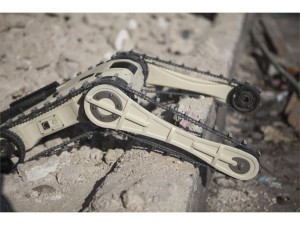
The Israeli robotics developer Roboteam is introducing a new miniature robot designed for intelligence gathering and counter IED (C-IED) operations. The ultra-light, 13-lb, highly maneuverable robot can be carried by an individual soldier, climbs stairs and 60⁰ obstacles, operates effectively indoors utilizing secure MANET data link.
Subscribe to get the full version of this articleExternally, MTGR looks different than any robot today. At a gross weight of 13 pounds (5.9kg), the backpacked MTGR weighs less than half of other robots in its climbing stairs class. “Through the development we fought on every gram and every cent, to come up with a robot that will be truly suitable for operation by a single soldier” Wolf said, the platform comprises carbon fibers for the elements carrying the highest loads and impact, with other composites forming other parts and covers for. Curved shapes were employed to carry loads or and absorb impact at minimum weight. Hollow tracks have also saved weight without compromising on performance and reliability.
The propulsion system used was optimized to deliver large torque and high speed at the same time. MTGR is designed to operate in extreme environmental conditions, including wet, dusty and dark environments. It can fully operate after falling from a height of several meters. And can automatically upright itself, if it lands on the side or flipped on its back. The robot can rapidly climbs tall stairs and overcome large vertical obstacles. MTGR can carry any add–on up to 10 pounds such as manipulator and or explosives
The MTGR is designed to deliver video and acoustic intelligence, surveillance and reconnaissance. Fitted with built-in color-zoom video camera and laser illuminator, both can tilt up or down, and additional four low-light CMOS cameras covering 360 degrees, the robot has a standard accessory port interfacing with power, Ethernet, RS232 and video / data connection. Mil Std. 1913 Picatiny rail accepts an additional day/night camera, a micro-manipulator to move debris or emplace counter-IED micro-charges. Another sensor payload called SAFIRE developed by the company, provides real time distance measurement using passive multi stereoscopic image processing (instead of Laser radar LIDAR), for semi-autonomous operations. Other built-in features include a GPS receiver, inertial sensors and magnetic compass, allowing position reporting (Blue Force Tracking) and C4I integration even when the robot operates in GPS denied areas, underground or indoors.
A unique feature employed in all its robots is the use of secure digital datalink employing Mobile MESH network. This architecture enables robots to communicate with other MESH network nodes to increase operational distance. This digital datalink technology is based on advanced, commercial-off-the-shelf (COTS) elements facilitating fully encrypted, COMSEC protected two-way datalink, with efficient spectrum utilization enabling multi-robot operating environment.

The Remote Operation Control Unit (ROCU7) developed by the company complements the robotic system, addressing the requirement for ‘simple and intuitive operation’. The control unit comes with HD 7” display, and controls derived from the videogame world. These MIL-STD NVIS compliant systems operate with either Android or Windows 7 operating systems. Both the ROCU and the robot itself operate with standard BA-2557 batteries, therefore simplifying field sustainment. The robot operates for 3.5 hours and ROCU can operate for four hours. The company has also developed larger (10” and smaller 5”) versions of ROCU to support other applications.

The smaller ROCU5 supports the Individual Robotic Intelligence System (IRIS), a throwable, miniature 4×4 robot weighing 2.2 pounds (les than 1 kg), designed to extreme maneuverability.
IRIS will be thrown into the target area, (it can absorb an impact falling 10 meters high). IRIS uses the same datalink of the MTGR and, therefore, can act as a node in the datalink MESH network supporting multiple robots. With extremely power efficient, IRIS can run on six AA batteries for up to four hours. IRIS is designed as a compact system, enabling the warfighter to carry it in a side pocket or a thigh case.



















